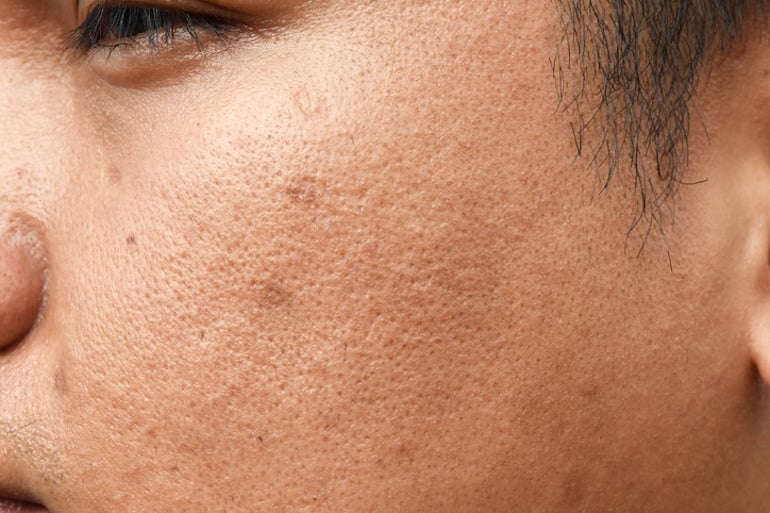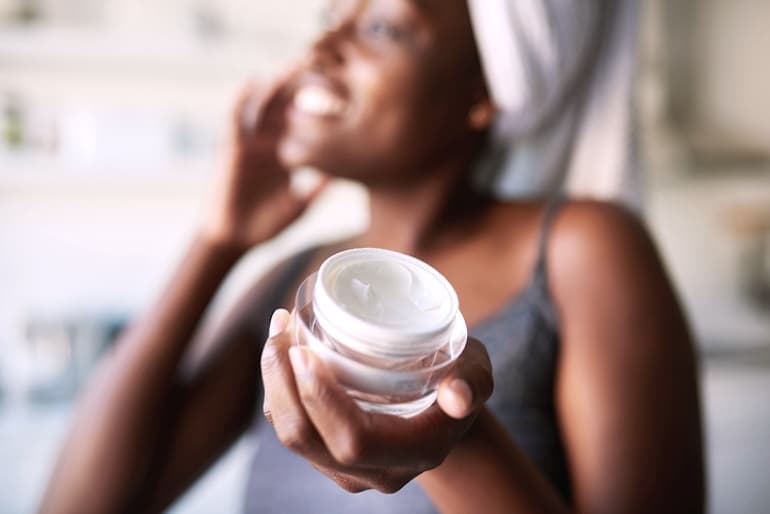A dermatologist explains the causes and different types of acne scars, plus how to get rid of them.
Acne is challenging to deal with, and it often instigates different kinds of discomfort. Even after the inflammation clears, you might be left with an unwelcome parting gift in the form of scarring.
If you experience post-acne scarring, don’t despair. According to cosmetic dermatologist Michele Green, MD, time, patience, and the right treatments can help treat your acne scars.
WHAT CAUSES ACNE SCARs?
To understand what causes acne scarring, we need to first understand acne, which results from clogged pores.
Typically, this clogging occurs when excess oil (aka sebum) combines with dead skin cells to block the entrance of the pore. When a pore clogs, bacteria can build inside it, leading to inflammation and causing acne to form.
The inflammation that causes acne to appear in the first place is ultimately what also causes scarring. As Dr. Green explains, “The infection causes the destruction of the skin and prevents it from healing properly.”
The types of scars that subsequently develop depend on the skin’s reaction to this inflammation.
Different Types of Acne Scars
Acne scars come in a few different varieties, but can usually be categorized in one of four types:
- atrophic scars
- hypertrophic scars
- keloids
- hyperpigmentation
1. Atrophic Scars
In most cases, atrophic acne scarring appears on the face and presents itself as depressions in the skin. Dr. Green explains that atrophic scars generally form “due to the skin’s inability to produce enough collagen as the wound heals.”
Then, there are three types of atrophic acne scarring:
- ice pick scars
- boxcar scars
- rolling scars
Ice Pick Scars
First, ice pick scars look like deep holes in the skin. Dr. Green says that ice pick scars commonly form when there’s a loss of skin tissue that “results in a perforation of the skin that looks like a narrow, deep hole.”
Boxcar Scars
Second, boxcar scars are wider than ice pick scars and usually look more like an indentation than a hole. According to Dr. Green, this type of acne scar forms when inflammatory acne destroys collagen in the skin. She explains that collagen plays a critical role to structurally support skin tissue, and a lack of it can cause the skin to sink inwards.
Rolling Scars
Lastly, rolling scars have less defined edges and aren’t as deep as the other two types of atrophic scars. Dr. Green says that these scars form when fibrous bands of tissue build up between the uppermost layer of skin and a deeper layer of tissue. These fibrous bands pull the top layer of skin inwards creating an uneven, rolling appearance.
2 & 3. Hypertrophic and Keloidal Scars
Whereas atrophic scars create skin indentations, hypertrophic and keloidal scars cause a raised skin growth. Both form when the body overproduces collagen to the point that the scar raises out of the skin.
Even for dermatologists, it can be difficult to determine whether a raised scar is a hypertrophic scar or a keloid. However, a 2020 study published in the British Journal of Dermatology distinguished the differences between the two types of acne scars as such:
Hypertrophic Scars
- grow within the borders of the original wound
- can eventually grow smaller
Keloid Scars
- grow larger than the borders of the original wound
- don’t grow smaller on their own
- have very thick bands of connective tissue in their inner layer
Though all sorts of skin types can develop hypertrophic and keloidal scars, Dr. Green points out that people with darker skin are more susceptible to developing keloids.
4. Hyperpigmentation
While hyperpigmentation isn’t technically considered a scar, it’s still a common result of acne.
Characterized by a dark spot where the breakout previously existed, hyperpigmentation is caused by an overproduction of melanin. Again, people with darker skin tones are more prone to developing hyperpigmentation.
Can you prevent acne scars from forming?
Unfortunately, there’s no magic cure to prevent acne scars from forming.
That said, Dr. Green explains that the best way to reduce the likelihood of acne scars from forming is to stay on top of your skincare routine to minimize the chances of acne forming to begin with.
How to Get Rid of Acne Scars
When looking for acne scar treatments, it’s important to manage your expectations. Scarring indicates that the skin has been damaged—and if the damage is severe enough, it may not be possible for the scar to entirely disappear.
However, here are some effective, derm-approved ways to help heal your acne scars.
Use the Right Products
For starters, the right skincare products can help get rid of acne scars.
Luckily, there quite a few topical ingredients that can help fade dark spots, such as:
- exfoliating AHAs + BHAs (like salicylic acid)
- retinol
- vitamins C + E
- kojic acid
Be kind to Your Skin
In addition to following a skincare routine with products tailored to your skin type and concerns, take care to be gentle and treat your skin well.
First, remember to exfoliate to promote skin cell turnover. Also, as tempting as it can be, don’t pop your pimples. Picking at your skin will only increase the likelihood of scars.
Consult a Derm for Professional Treatments
If your acne scars still won’t heal and you think you need medical-grade treatments, Dr. Green recommends being intentional about the doctor you select to help you address your skin concerns.
For instance, she suggests that people with hypertrophic and keloidal scars should find a board-certified dermatologist or cosmetic surgeon with experience in treating those types of scars.
Once you’ve found a doctor you feel comfortable with, you can then discuss a variety options to promote healing.
The most common medical treatments for acne scars include:
- laser therapy: stimulates collagen production in a targeted area
- subcision: a needle loosens up the skin under the scar
- dermal fillers: injected under the scar to temporarily lift the skin back into place; typically the best solution with collagen loss
Medical acne scar treatments involve a process that happens slowly over time. You may need to work with your doctor to try a few different treatments, which can sometimes take months.
Final Thoughts
Again, it may not be possible to fully prevent acne scars from forming. Still, you can always take care to prevent breakouts in the first place. From there, look to the best ways to treat acne scars as discussed above.
No matter what type of acne scar you have, Dr. Green encourages maintaining a positive mindset. “It’s very rare to be unable to get rid of acne scars,” she reassures us.
So even if you can’t erase the scar entirely, in most cases, you’ll notice visible improvements.











